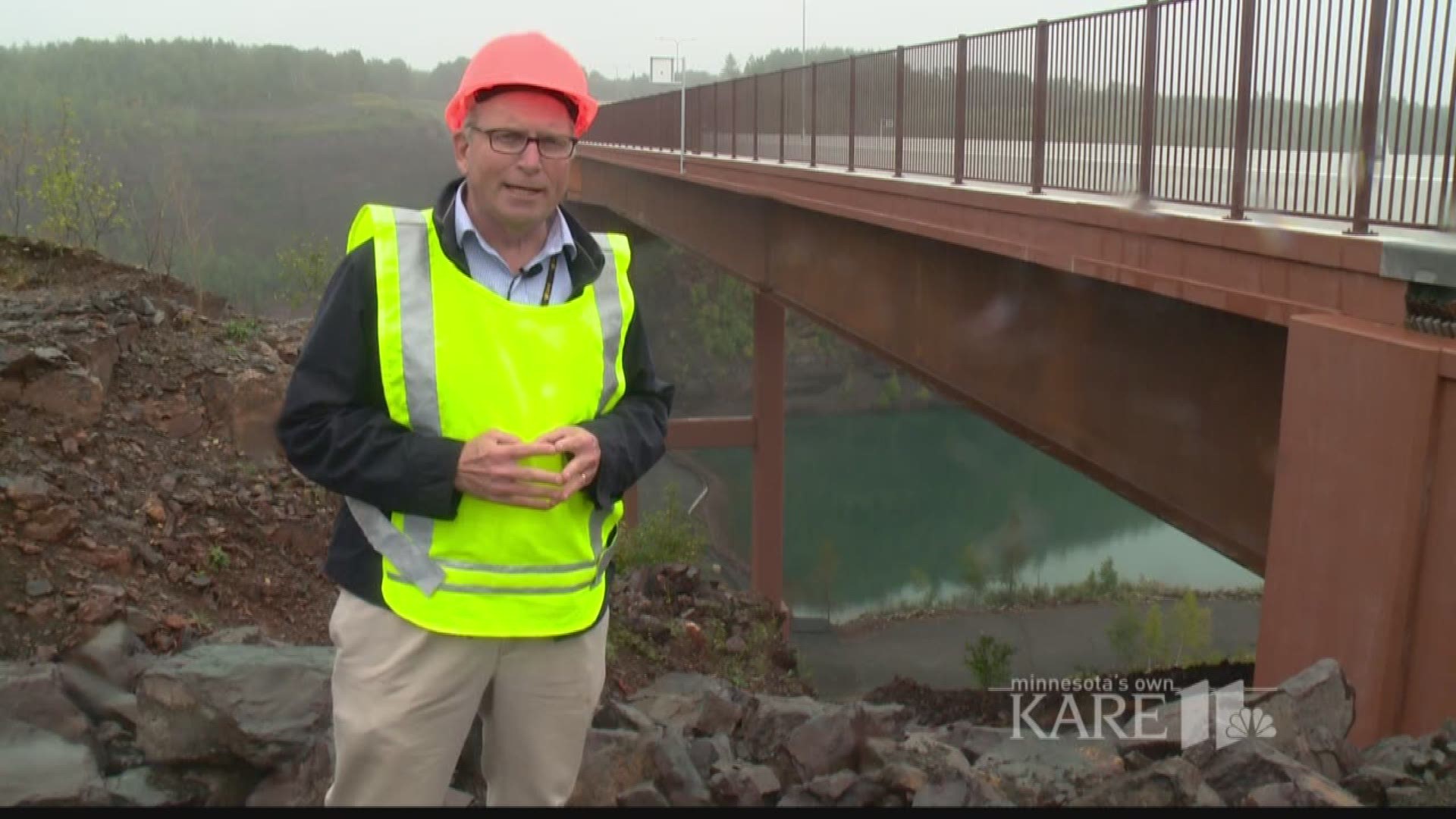VIRGINIA, Minn. -- The new U.S. Highway 53 Bridge will open to traffic this weekend, but Friday was the day for those involved in the massive project to celebrate resilience and determination of people on the Iron Range.
Hundreds of people, including construction workers, local residents, MnDOT crew members and politicians, gathered below the bridge Friday for a dedication ceremony.
The Eveleth-Gilbert High School Band performed and Lt. Governor Tina Smith officially christened the bridge by smashing a bottle of Robert Mondavi Riesling against one of the piers. And yes, Mondavi was born in Virginia.
"This project is a testimony to the strength of the Range," Smith told the crowd. "Projects like this don’t just happen!"
The route, spanning the Rouchleau Mine pit between Virginia and Eveleth, was picked during a lengthy process that included community listening sessions. An early option -- a lengthy bypass around the United Taconite Mine in Eveleth -- was abandoned after strong opposition by local residents and business owners.
"It's a testament to the value, significance and importance of mining," Congressman Rick Nolan exclaimed.
"The bridge is made with all 100 percent American made steel, built by 100 percent union workers and contractors!"
The $240 million relocation project is mostly paid for with state, with $30 million in federal funds, plus at least $5 million in contributions from local communities on related utility infrastructure work.
Some of the stats associated with the project are jaw dropping -- 10 million pounds of steel bridge beams, 800,000 pounds of rebar --numbers that play well in a region built around mining iron ore.
"It’s only fitting that the Iron Range, after building America and building all the bridges in the Twin Cities, should have the highest bridge in the state of Minnesota," St. Louis County Commissioner Tom Rukavina told KARE.
Will White of Kiewit Companies, the general contractor on the project, stressed that there were no workplace injuries during the project, which is running a month ahead of schedule.
Aaron Kloss, one of the local laborers who worked on pouring the concrete deck, said that Kiewit managers went out of their way to get workers what they needed to keep them out of harm's way. He said they also held some family events, so workers could show their children the project.
"It was just incredible to show our kids what we can build," Kloss, a father of four, told KARE. "I mean look at it! It’s huge!"
Relocation
Highway 53 was built on land the state leased from the mining companies, but five years ago those companies exercised their option to mine the earth under the roadway. In other words, MnDOT had to find a place to move a major four-lane highway.
The original 1960 agreement called for the mining companies to pay for the relocation if they asked for it before 1987. But if the road needed to be moved after 1987 the contract called for the government to pick up the tab.
MnDOT purchased the mineral rights below the new bridge and fanning out from the piers, in an effort to make the relocated traffic link more permanent.
"MnDOT owns those minerals," Pat Huston, MnDOT's project director, explained. "That doesn’t mean the road can’t move, but what it does mean is some company's going to have to pay for the mineral rights and pay to move the highway, theoretically."
200 feet high
Until now the Smith Avenue Bridge, aka "High Bridge," in St. Paul was the highest bridge deck in the state, at 140 feet above the Mississippi. And those who thought Duluth's Blatnik Bridge was the highest in the state, Huston said the top arch of that bridge would be even with the Highway 53 driving deck.
He said some people with a fear of heights have said being on the bridge deck isn't as scary as they thought it would be.
"We have 42 inch railings and you still see the horizon," he said. "And at 50 miles an hour, which is the speed limit, it only takes 15 seconds to get across!"
Traffic will begin to move on the bridge in the coming days, but work will continue on the approaches and lane switches until November 15.
The water that fills the Rouchleau Pit is now the city of Virginia's main drinking water source, so the bridge designers created a drainage system that captures the surface runoff from the bridge in retaining ponds so it can be treated.

